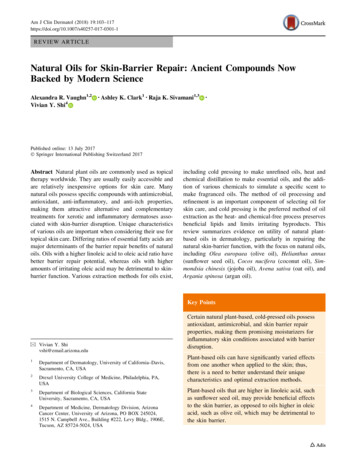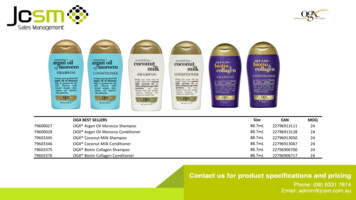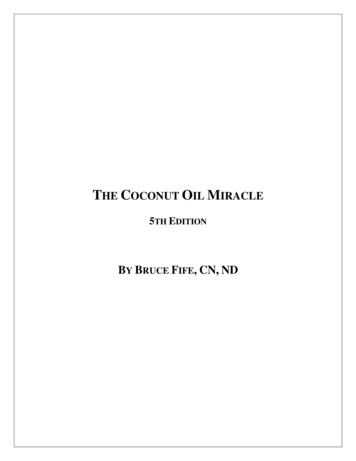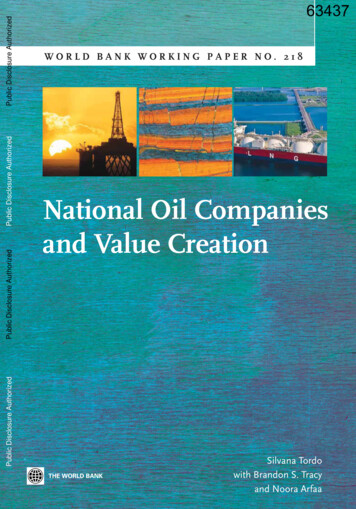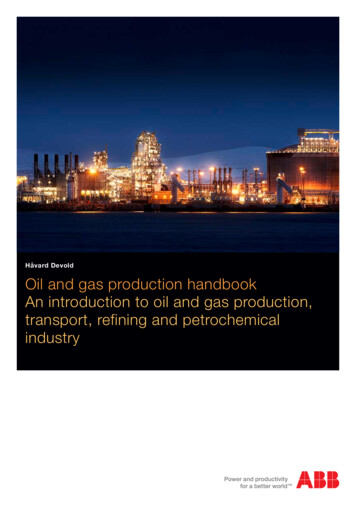
Transcription
Håvard DevoldOil and gas production handbookAn introduction to oil and gas production,transport, refining and petrochemicalindustry
ISBN 978-82-997886-3-22
PREFACEThis handbook has been compiled for readers with an interest in the oil andgas industry. It is an overview of the main processes and equipment. Whenwe searched for a suitable introduction to be used for new engineers, Idiscovered that much of the equipment is described in standards, equipmentmanuals and project documentation. Little material was found to quickly givethe reader an overview of the entire oil and gas industry, while stillpreserving enough detail to let the engineer have an appreciation of the maincharacteristics and design issues.I have had many requests that downstream processes be included, andhave restructured the book into Upstream, Midstream, Refining andPetrochemical, adding basic information on these facilities. The main focusof the book is still the upstream production process.This book is by no means a complete description on the detailed design ofany part of this process, and many details have been omitted in order tosummarize a vast subject.The material has been compiled from various online resources, as well asABB and customer documents. I am grateful to my colleagues in the industryfor providing their valuable input and comments. I have included manyphotos to give you, the reader, an impression of what typical facilities orequipment look like. Non-ABB photo sources are given below pictures; otherpictures and illustrations are copyrighted by ABB.Edition 3.0 Oslo, August 2013Håvard Devold 2006 - 2013 ABB Oil and GasExcept as otherwise indicated, all materials, including but not limited to design, text, graphics,other files, and the selection and arrangement thereof, are the copyright property of ABB, ALLRIGHTS RESERVED. You may electronically copy and print a hard-copy of this document onlyfor non-commercial or personal use, within the organization that employs you, provided that thematerials are not modified and all copyright or proprietary notices are retained. Use of photosand graphics and references from other sources in no way promotes or endorses theseproducts and services and is for illustration only. Pictures credited to Wikipedia are licensedunder GNU Free Documentation License (GFDL) or Public Domain (PD) and are published herewith the same license. Originals and full information can be found on www.wikimedia.org.b
CONTENTSIntroduction. 1Facilities and processes . 42.1Exploration . 42.2Production . 52.2.1Onshore . 72.2.2Offshore . 82.3Upstream process sections . 122.3.1Wellheads . 122.3.2Manifolds and gathering . 132.3.3Separation. 142.3.4Metering, storage and export . 152.3.5Utility systems . 162.4Midstream . 162.4.1Gas Plants . 162.4.1Gas compression . 172.4.2Pipelines . 172.4.1LNG liquefaction and regasification facilities . 182.5Refining . 182.6Petrochemical . 193Reservoir and wellheads . 213.1Crude oil and natural gas . 213.1.1Crude oil. 213.1.2Natural gas. 233.1.3Condensates . 243.2The reservoir . 243.3Exploration and drilling . 263.4The well . 293.4.1Well casing. 293.4.2Completion . 313.5Wellhead . 323.5.1Subsea wells . 343.5.2Injection. 353.6Artificial lift . 353.6.1Rod pumps. 353.6.2ESP . 363.6.3Gas lift . 363.6.4Plunger lift . 373.7Well workover, intervention and stimulation . 384The upstream oil and gas process . 40414.1Manifolds and gathering . 42I12
Pipelines and risers . 424.1.14.1.2Production, test and injection manifolds . 424.2Separation . 434.2.1Test separators and well test . 434.2.2Production separators . 434.2.3Second stage separator . 454.2.4Third stage separator . 454.2.5Coalescer . 464.2.6Electrostatic desalter . 464.2.7Water treatment . 464.3Gas treatment and compression . 484.3.1Heat exchangers . 484.3.2Scrubbers and reboilers . 494.3.3Compressors, anti-surge and performance . 504.4Oil and gas storage, metering and export . 554.4.1Fiscal metering. 554.4.2Storage . 574.4.3Marine loading . 585Midstream facilities . 595.1Gathering . 595.2Gas plants . 595.2.1Gas composition . 595.3Gas processing. 625.3.1Acid gas removal . 635.3.2Dehydration. 645.3.3Mercury removal . 645.3.4Nitrogen rejection . 655.3.5NGL recovery and treatment . 655.3.6Sales gas specifications . 655.4Pipelines . 675.4.1Pipeline terminal . 675.4.2Gas Pipelines, compressor and valve stations . 675.4.3Liquid pipelines, pump and valve stations . 685.4.4Pipeline management, control and safety . 695.5LNG . 705.5.1LNG liquefaction . 715.5.2Storage, transport and regasification . 766Refining . 776.1Fractional distillation . 776.2Basic products . 786.3Upgrading and advanced processes . 806.4Blending and distribution . 857Petrochemical. 87II
Aromatics . 887.17.1.1Xylene and polyester chain. 897.1.2Toluene, benzene, polyurethane and phenolic chain . 907.1.3Benzene and styrenic chain, derivatives . 917.2Olefins . 927.2.1Ethylene, derivatives . 937.2.2Propylene, derivatives . 947.2.3Butadiene, butylenes, and pygas, derivatives . 967.3Synthesis gas (syngas) . 977.3.1Methanol based products . 987.3.2Ammonia based products . 998Utility systems . 1008.1Process control systems. 1008.1.1Safety systems and functional safety . 1038.1.2Emergency shutdown and process shutdown . 1058.1.3Fire and gas system . 1078.1.4Control and safety configuration . 1088.1.5Telemetry/SCADA . 1108.2Digital oilfield . 1118.2.1Reservoir management and drilling operations . 1128.2.2Production optimization . 1128.2.3Asset optimization and maintenance support . 1138.2.4Information management systems (IMS) . 1158.2.5Training simulators . 1168.3Power generation, distribution and drives . 1178.4Flare and atmospheric ventilation . 1198.5Instrument air. 1208.6HVAC . 1208.7Water systems . 1208.7.1Potable water . 1208.7.2Seawater . 1218.7.3Ballast water . 1218.8Chemicals and additives . 1218.9Telecom . 1249Unconventional and conventional resources and environmental effects1279.1Unconventional sources of oil and gas. 1279.1.1Extra heavy crude . 1289.1.2Tar sands . 1289.1.3Oil shale . 1299.1.4Shale gas and coal bed methane . 1309.1.5Coal, gas to liquids and synthetic fuel . 1319.1.6Methane hydrates . 132III
Biofuels . 1339.1.79.1.8Hydrogen . 1359.2Emissions and environmental effects . 1359.2.1Indigenous emissions . 1369.2.2Greenhouse emissions . 1369.2.3Carbon capture and sequestration . 13910 Units . 14111 Glossary of terms and acronyms . 14312 References . 14713 Index. 148-IV
1 IntroductionOil has been used for lighting purposes for many thousands of years. Inareas where oil is found in shallow reservoirs, seeps of crude oil or gas maynaturally develop, and some oil could simply be collected from seepage ortar ponds.Historically, we know the tales of eternal fires where oil and gas seepsignited and burned. One example is the site where the famous oracle ofDelphi was built around 1,000 B.C. Written sources from 500 B.C. describehow the Chinese used natural gas to boil water.It was not until 1859 that "Colonel" Edwin Drake drilled the first successful oilwell, with the sole purpose of finding oil. The Drake Well was located in themiddle of quiet farm country in northwestern Pennsylvania, and sparked theinternational search for an industrial use for petroleum.Photo: Drake Well Museum Collection, Titusville, PAThese wells were shallow by modern standards, often less than 50 metersdeep, but they produced large quantities of oil. In this picture of the TarrFarm, Oil Creek Valley, the Phillips well on the right initially produced 4,0001
barrels per day in October, 1861, and the Woodford well on the left came inat 1,500 barrels per day in July, 1862.The oil was collected in the wooden tank pictured in the foreground. As youwill no doubt notice, there are many different-sized barrels in thebackground. At this time, barrel size had not been standardized, which madestatements like "oil is selling at 5 per barrel" very confusing (today a barrelis 159 liters (see units on p. 141). But even in those days, overproductionwas something to be avoided. When the "Empire well" was completed inSeptember 1861, it produced 3,000 barrels per day, flooding the market, andthe price of oil plummeted to 10 cents a barrel. In some ways, we see thesame effect today. When new shale gas fields in the US are constrained bythe capacity of the existing oil and gas pipeline network, it results inbottlenecks and low prices at the production site.Soon, oil had replaced most other fuels for motorized transport. Thethautomobile industry developed at the end of the 19 century, and quicklyadopted oil as fuel. Gasoline engines were essential for designing successfulaircraft. Ships driven by oil could move up to twice as fast as their coalpowered counterparts, a vital military advantage. Gas was burned off or leftin the ground.Despite attempts at gas transportation as far back as 1821, it was not untilafter World War II that welding techniques, pipe rolling, and metallurgicaladvances allowed for the construction of reliable long distance pipelines,creating a natural gas industry boom. At the same time, the petrochemicalindustry with its new plastic materials quickly increased production. Evennow, gas production is gaining market share as liquefied natural gas (LNG)provides an economical way of transporting gas from even the remotestsites.With the appearance of automobiles and more advanced consumers, it wasnecessary to improve and standardize the marketable products. Refiningwas necessary to divide the crude in fractions that could be blended toprecise specifications. As value shifted from refining to upstream production,it became even more essential for refineries to increase high-value fuel yieldfrom a variety of crudes. From 10-40% gasoline for crude a century ago, amodern refinery can get up to 70% gasoline from the same quality crudethrough a variety of advanced reforming and cracking processes.Chemicals derived from petroleum or natural gas – petrochemicals – are anessential part of the chemical industry today. Petrochemistry is a fairly young2
industry; it only started to grow in the 1940s, more than 80 years after thedrilling of the first commercial oil well.During World War II, the demand for synthetic materials to replace costlyand sometimes less efficient products caused the petrochemical industry todevelop into a major player in modern economy and society.Before then, it was a tentative, experimental sector, starting with basicmaterials: Synthetic rubbers in the 1900s Bakelite, the first petrochemical-derived plastic, in 1907 First petrochemical solvents in the 1920s Polystyrene in the 1930sAnd it then moved to an incredible variety of areas: Household goods (kitchen appliances, textiles, furniture) Medicine (heart pacemakers, transfusion bags) Leisure (running shoes, computers.) Highly specialized fields like archaeology and crime detectionWith oil prices of 100 a barrel or more, even more difficult-to-accesssources have become economically viable. Such sources include tar sandsin Venezuela and Canada, shale oil and gas in the US (and developingelsewhere), coal bed methane and synthetic diesel (syndiesel) from naturalgas, and biodiesel and bioethanol from biological sources have seen adramatic increase over the last ten years. These sources may eventuallymore than triple the potential reserves of hydrocarbon fuels. Beyond that,there are even more exotic sources, such as methane hydrates, that someexperts claim can double available resources once more.With increasing consumption and ever-increasing conventional andunconventional resources, the challenge becomes not one of availability, butof sustainable use of fossil fuels in the face of rising environmental impacts,that range from local pollution to global climate effects.3
2 Facilities and processesThe oil and gas industry facilities and systems are broadly defined,according to their use in the oil and gas industry production stream:ExplorationIncludes prospecting, seismic and drilling activities that takeplace before the development of a field is finally decided.UpstreamTypically refers to all facilities for production and stabilizationof oil and gas. The reservoir and drilling community oftenuses upstream for the wellhead, well, completion andreservoir only, and downstream of the wellhead oduction together is referred to as E&P.MidstreamBroadly defined as gas treatment, LNG production andregasification plants, and oil and gas pipeline systems.RefiningWhere oil and condensates are processed into marketableproducts with defined specifications such as gasoline, dieselor feedstock for the petrochemical industry. Refinery offsitessuch as tank storage and distribution terminals are includedin this segment, or may be part of a separate distributionsoperation.Petrochemical These products are chemical products where the mainfeedstock is hydrocarbons. Examples are plastics, fertilizerand a wide range of industrial chemicals.2.1 ExplorationIn the past, surface featuressuch as tar seeps or gaspockmarks provided initialclues to the location ofshallowhydrocarbondeposits. Today, a series ofsurveys, starting with broadgeological mapping throughincreasinglyadvancedmethods such as passiveseismic, reflective seismic,magnetic and gravity surveys give data to sophisticated analysis tools thatidentify potential hydrocarbon bearing rock as “prospects.” Chart: NorwegianPetroleum Directorate (Barents Sea)4
An offshore well typically costs 30 million, with most falling in the 10- 100million range. Rig leases are typically 200,000 - 700,000 per day. Theaverage US onshore well costs about 4 million, as many have much lowerproduction capacity. Smaller companies exploring marginal onshore fieldsmay drill a shallow well for as little as 100,000.This means that oil companies spend much time on analysis models of goodexploration data, and will only drill when models give a good indication ofsource rock and probability of finding oil or gas. The first wells in a region arecalled wildcats because little may be known about potential dangers, such asthe downhole pressures that will be encountered, and therefore requireparticular care and attention to safety equipment.If a find (strike, penetration) is made, additional reservoir characterizationsuch as production testing, appraisal wells, etc., are needed to determine thesize and production capacity of the reservoir in order to justify a developmentdecision.2.2 ProductionThis illustration gives an overview of typical oil and gas production facilities:Figure 1. Oil and gas production facilities5
Although there is a wide range of sizes and layouts, most productionfacilities have many of the same processing systems shown in this d TestManifoldsMetering andstorageGas ePigLauncherProduction SeparatorsOilPipeline1 stageTankerLoading2 stageøCrudepumpOilMeterWater treatmentTest SeparatorOil StorageDrillingInjectionwellsUtility systems (selected)Power GenerationInjectionmanifoldWater injectionpumpMud and CementingInstrument AirPotable WaterGas injectioncompressorFirefightingsystemsHVACFigure 2. Oil and gas production overview6
Today, oil and gas is produced in almost every part of the world, from thesmall 100 barrels-a-day private wells to the large bore 4,000 barrels-a-daywells; in shallow 20 meter deep reservoirs to 3,000 meter deep wells in morethan 2,000 meters of water; in 100,000 onshore wells and 10 billionoffshore developments. Despite this range, many parts of the process arequite similar in principle.At the left side, we find the wellheads. They feed into production and testmanifolds. In distributed production, this is called the gathering system. Theremainder of the diagram is the actual process, often called the gas oilseparation plant (GOSP). While there are oil- or gas-only installations, moreoften the well-stream will consist of a full range of hydrocarbons from gas(methane, butane, propane, etc.), condensates (medium densityhydrocarbons) to crude oil. With this well flow, we also get a variety ofunwanted components, such as water, carbon dioxide, salts, sulfur andsand. The purpose of the GOSP is to process the well flow into clean,marketable products: oil, natural gas or condensates. Also included are anumber of utility systems, which are not part of the actual process butprovide energy, water, air or some other utility to the plant.2.2.1 OnshoreOnshore production is economicallyviable from a few dozen barrels of oila day and upward. Oil and gas isproduced from several million wellsworldwide. In particular, a gasgathering network can become verylarge, with production from rt,feedingthrough a gathering network into aprocessing plant. This picture shows awell, equipped with a sucker rod pump(donkey pump) often associated withonshore oil production. However, aswe shall see later, there are manyother ways of extracting oil from a nonfree-flowing well. For the smallest reservoirs, oil is simply collected in aholding tank and picked up at regular intervals by tanker truck or railcar to beprocessed at a refinery.Onshore wells in oil-rich areas are also high capacity wells producingthousands of barrels per day, connected to a 1,000,000 barrel or more per7
day GOSP. Product is sent from the plant by pipeline or tankers. Theproduction may come from many different license owners, so metering ofindividual well-streams into the gathering network are important tasks.Unconventional plays target veryheavy crude and tar sands thatbecame economically extractablewith higher prices and newtechnology. Heavy crude mayneed heating and diluents to beextracted. Tar sands have losttheir volatile compounds and arestrip-mined or can be extractedwith steam. It must be furtherprocessed to separate bitumenfrom the sand. Since about 2007,drilling technology and fracturingof the reservoir have allowedshale gas and liquids to beproduced in increasing volumes.This allows the US in particular toreducedependenceonhydrocarbon imports. Canada,China, Argentina, Russia, Mexicoand Australia also rank among thetop unconventional plays. Theseunconventional reserves maycontain more 2-3 times thehydrocarbons found in conventional reservoirs. These pictures show theSyncrude Mildred plant at Athabasca, Canada Photo: GDFL Jamitzky/Wikimediaand the Marcellus Shale in Pennsylvania. Photo: GDFL Ruhrfisch /Wikimedia2.2.2 OffshoreA whole range of different structures is used offshore, depending on size andwater depth. In the last few years, we have seen pure sea bottominstallations with multiphase piping to shore, and no offshore topsidestructure at all. Replacing outlying wellhead towers, deviation drilling is usedto reach different parts of the reservoir from a few wellhead cluster locations.Some of the common offshore structures are:8
Shallow water complex, whichis characterized by severalindependentplatformswithdifferent parts of the processand utilities linked with gangwaybridges. Individual tionsand power generation platforms.(This picture shows the BPValhall complex.) Typically foundin water depths up to 100meters.Gravity base consists of enormousconcrete fixed structures placed on thebottom, typically with oil storage cells ina "skirt" that rests on the sea bottom.The large deck receives all parts of theprocess and utilities in large modules.Large fields at 100 to 500 meters ofwater depth were typical in the 1980sand 1990s. The concrete was poured atan onshore location, with enough air inthe storage cells to keep the structurefloating until tow-out and lowering ontothe seabed. The picture shows theworld's largest GBS platform, Troll A,during construction. Photo StatoilCompliant towers are much like fixedplatforms. They consist of a narrowtower, attached to a foundation on theseafloor and extending up to theplatform. This tower is flexible, asopposed to the relatively rigid legs of afixed platform. Flexibility allows it to operate in much deeper water, as it canabsorb much of the pressure exerted by the wind and sea. Compliant towersare used between 500 and 1,000 meters of water depth.Floating production, where all topside systems are located on a floatingstructure with dry or subsea wells. Some floaters are:9
FPSO:FloatingProduction,Storage and Offloading. Theirmain advantage is that they are astandalone structure that does notneed external infrastructure suchas pipelines or storage. Crude oilis offloaded to a shuttle tanker atregular intervals, from days toweeks, depending on productionand storage capacity. FPSOscurrently produce from around10,000 to 200,000 barrels per day.An FPSO is typically a tanker typehull or barge, often converted froman existing crude oil tanker (VLCCor ULCC). Due to the increasingsea depth for new fields, theydominate new offshore fielddevelopment at more than 100meters water depth.The wellheads or subsea risersfrom the sea bottom are locatedon a central or bow-mountedturret, so that the ship can rotatefreely to point into wind, waves orcurrent. The turret has wire ropeand chain connections to severalanchors (position mooring POSMOOR), or it can bedynamicallypositionedusingthrusters (dynamic positioning –DYNPOS). Most installations usesubsea wells. The main process isplaced on the deck, while the hullis used for storage and offloadingto a shuttle tanker. It may also beused for the transportation ofpipelines.FPSOs with additional processingand systems, such as drilling andproduction and stranded gas LNGproduction are planned.10 page
the capacity of the existing oil and gas pipeline network, it results in bottlenecks and low prices at the production site. Soon, oil had replaced most other fuels for motorized transport. The automobile industry developed at the end of the 19th century, and quickly adopted oil as fuel. Gasoline engines wer




